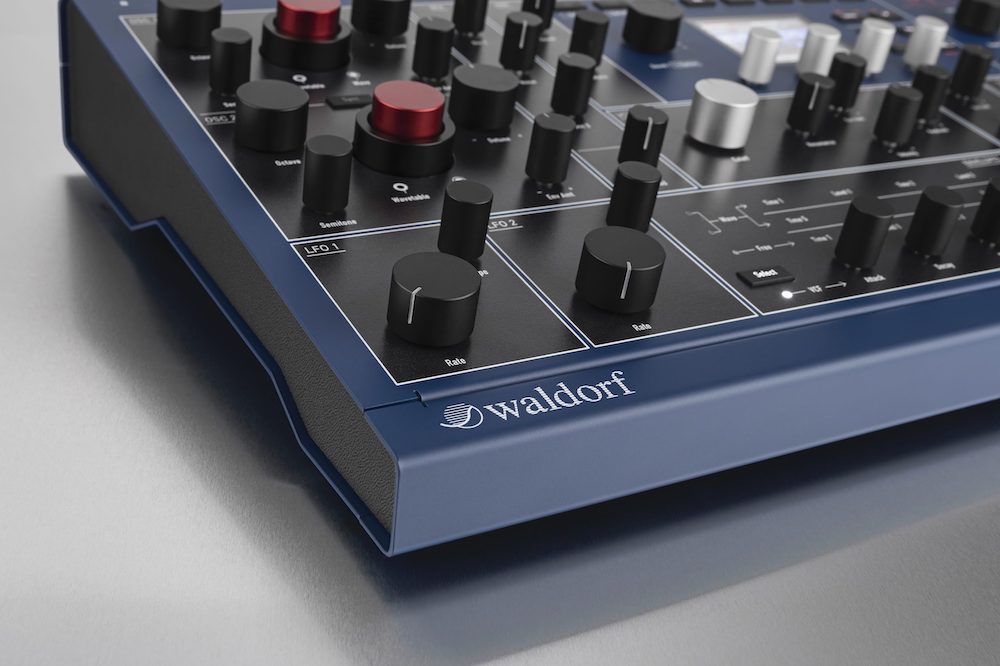Based on the legendary Microwave synths, the M offers hybrid wavetable sounds with analogue filters. Greg Scarth discovers how compelling this combination sounds.

In recent years, we’ve seen more and more affordable synth, both analogue and digital, hit the market. It’s easier than ever to get your hands on high-quality synth hardware, but is there still a demand for high-end synths? Waldorf certainly think so, and the fact that it’s been so hard to get our hands on the Waldorf M since its launch last year backs up that theory.
It’s worth a quick recap on the Waldorf brand and their synth philosophy to kick things off. While never as much of a household name as brands like Moog, Roland and Korg, Waldorf’s contribution to modern synth design shouldn’t be underestimated. The company grew out of the ashes of PPG, another German brand run by engineer Wolfgang Palm, who pioneered the concept of wavetable synthesis in the late 70s and marketed the high-end Wave range of synths in the 80s. Using cutting-edge digital technology, the wavetable concept allowed Palm to approach synthesis via tables of digital waveforms rather than traditional analogue oscillators, opening up a world of new, exciting sounds. As the PPG company dissolved in the late 80s, Waldorf took over the wavetable concept, which is where the story of the M really begins. A hybrid design with wavetable oscillators and analogue filters, the M is heavily inspired by the classic Waldorf Microwave series, first released in 1989 and developed with subsequent models over the following decade.

To start with the basics, the M is a desktop module available in two versions, the eight-voice model reviewed here and a 16-voice model which is otherwise more or less identical. Packed into the impressively sturdy metal casing is a wavetable synth architecture with two oscillators per voice and two contrasting tone generation models. These feed into analogue resonant low-pass filters with saturation, then stereo VCAs. Modulation comes via four envelope generators and two LFOs, all of which are laid out on a pleasingly intuitive front panel, with dedicated controls for all the main features laid out logically around a screen and encoders which handle menus, visual feedback and things like modulation routing.

The burning question is how the M sounds, and whether it sticks rigidly to impressions of the original Microwave. On the latter point, no, the M doesn’t set out to be a Microwave clone despite the many similarities. The extensive bank of 96 factory wavetables includes all the classic Microwave sounds, including PPG Wave 2.3 sounds. It’s well worth pointing out that the distinct Microwave I and II tone generation models provide quite different sounds. Classic Microwave I mode is old-school wavetable synthesis, running in 8-bit resolution and 240 kHz non-anti-aliased sample rate for crunchier tones. Modern Microwave II/XT mode runs in 16-bit at a 40 kHz sample rate with band-limited wavetables, and also offers hard sync and ring modulation for digital takes on those classic analogue tones.
The M’s filter circuits use the SSI 2144 chip, a modern version of the classic SSM 2044 chip designed by Dave Rossum. The 24dB/octave transistor ladder design was used in the classic PPG Wave 2.2 and 2.3 as well as a number of Korg synths including the Trident and Mono/Poly. It’s the combination of the wavetable sound source with these beautifully warm analogue filters which really makes the magic of the M. There’s something enticing about that combination of digital grit and analogue sizzle, especially when you start modulating the wavetables to achieve things other synths could only dream of.

The design of the M follows quite a purist approach, with the focus squarely on the raw synth sounds themselves. There’s a good arpeggiator but no sequencer and no effects, shifting the emphasis onto sound design rather than sequencing and processing. What you do get, however, is the bonus of four stereo aux outputs, allowing you to take advantage of the M’s four-part multitimbrality and assign each part its own stereo output for recording and processing. With a little careful sequencing, the M can happily handle complex arrangements single-handedly.

The M is a brilliant synth, packed with character. All of which just leaves the question of value. As we mentioned, the M is priced firmly in premium territory at just under £1,400 for the eight-voice model and a little under £2,000 for the 16-voice version. That substantial difference in price hints at a basic truth about polyphonic synths: analogue circuits cost money. There are plenty of cheaper wavetable synth modules on the market – including the ASM Hydrasynth, Modal Argon8m and Waldorf’s own Blofeld – but the sacrifice you make inevitably includes trading the M’s analogue filters and VCAs for digital circuits. Does that matter? Some would say not necessarily, and all three of those synths have a lot to offer, but the analogue filters in particular play a huge part in defining the captivating sound of the M. Waldorf products aren’t elitist (as the affordable price point of the Blofeld proves), but the M is an unashamedly high-end model with a high-end sound. It’s a worthy spiritual successor to the original Microwave and one which we expect to win a lot of admirers.
Greg Scarth
More info/buy